|
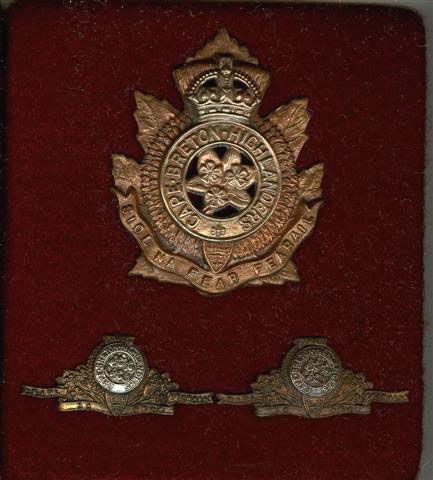
Cap Badge and Collar Badges of the Cape
Breton Highlanders of Canada
(Credit for photographs of the badges goes to Clifford Weirmeir, with
his splendid website about
the Irish
regiment of Canada)

The Cape Breton
Highlanders' wartime Camp Flag

This Cape Breton Highlanders of Canada Helmet Flash Decal
was worn on the left side of the MK II Helmet
Size: 1,25" x 1,25"

Source: www.warrelics.eu

The Tartan of
the Cape Breton Highlanders

This type of "Swinging Six" Sporran was worn by the Cape Breton
Highlanders' Pipe Band.
This article appeared in
the Cape Breton Post and explains much about the ethnic background
of the Cape Breton people:

EDITORIAL SECTION
A TRIBUTE TO THE CAPE BRETON HIGHLANDERS
By "E. M.A.” (J.
J. MacInnis)
The Hieland Laddie. That's a tune with the swing
of the Kilt in it; there's the challenge of true men in it, aye,
and the courage of stout hearts in it-a tune that is the battle
song of almost all the Highland regiments, but there is no
regiment that marches more proudly or with firmer step to its
stirring strains than the Cape Breton Highlanders.
These men are mostly all recruits from Cape
Breton, Nova Scotia, the most Highland Scottish District in all
Canada. It was formed in New Scotland, in the far continent
beyond the Hebrides. The first settlers were the veterans of the
North American Wars, old campaigners from the Fraser and
Montgomery Highlanders, the heroes who fought with Wolfe at
Quebec and with Murray at Montreal. After the peace of 1763 they
were offered grants of land. One condition of these grants was
that for every thousand acres under cultivation one reed of hemp
had to be sown so as to ensure sufficient cordage for the Kings
Navy. Masts were also supplied and within twenty years ships of
the line were built and commissioned for service with the
fleet.
But those old Campaigners were merely the
vanguard. The voyage of the "Hector" as she sailed from
Lochbroom in 1773 began a new chapter. The consequences of the
'45 denuded many of the straths and glens of the Highlands of
their manhood. They sailed for the new world where they and
their children could live in greater security. They were the men
who tanned the forest primeval and from the wilderness built the
many towns and villages that bear the names of Scotland’s
countryside, snaking permanent for generations to conic the ties
and memories of the homeland. It is with the fullest of that
sentiment which still lives on, that the pipes and drums of the
Cape Breton Highlanders "Pipe Band" play the slow march, the
strathspey, and the jaunty reels.
These hardy settlers experienced the difficulties
and the disappointments of all pioneers in a new land; honest,
forthright and self reliant men who were encouraged by their
faith in the future, and their faith never failed them. They
endured hardships hopefully and won through. Their descendents,
whose motto is "The breed of manly men" (Siol nam Fear fearal)
inherit these same qualities and from this settlement regiments
of volunteers were raised whenever danger threatened. During the
last great War the Town of New Waterford, in Cape Breton, sent
more men to the fighting forces than any other town of equal
size in the whole of the British Empire. The call for recruits
found such a ready response throughout the Province that the
maintenance of vital industries was in danger. Recruiting had to
be stopped in the mining areas. The battle honours of the
regiment are landmarks along the road to victory.
The Colonel who so gallantly led them in those
days new has the responsibility of shaping the military destiny
of the Dominion. He is the Right Hon. J. L. Ralston, I1linistcr
of National Defence at Ottawa. Another distinguished son of Cape
Breton Island is the Hon. Angus L. MacDonald Minister of Naval
Defence at Ottawa. When the period of waiting is over and when
the time comes for them to face the foe, The Cape Breton
Highlanders now over-seas, will remember the deeds of their
fighting brothers in the last war. They will remember too that
they now are "The Breed of Manly Men."
Miners, lumbermen, farmers and fishermen, these
Cape Breton Highlanders belong to a Province which produces
steel for Canada's war effort from the biggest steel mill in the
Dominion, and coal from mines which extend eight miles below the
waters of the Atlantic Ocean. Timber from the deep forest also
serves the needs of war while from the rich agricultural lands,
food is exported in larger quantities than ever before.
These Highlanders mustered immediately on the
outbreak of war and within a few hours they were standing guard
over their native shore on the Eastern seaboard of the Atlantic.
There they remained until the first Canadian armoured division
was being formed for service overseas. An infantry was wanted
with the special qualities of toughness for these new duties.
The Cape Breton Highlanders were selected and they have the
honour of being the first mechanized division.
May the Cape Breton Highlanders successfully go
on as they began with the "Hieland Laddie" and to its strains
they go marching on with all the confidence it inspires. It is
part of their inheritance from their Gaelic forebears. And when
the time comes for them to lay down their arms after victory it
will be said of them that they worthily maintained the honour of
being "The Breed of Manly Men" (do shiol na fear fearal).
"Slan gun till na Gaidheal ghasda Fada is farsuin
a chaídh cliu or."
-E.M.A.
Or, as
piper
Dan Gillis, in remembering his time in the C.B.H., later
described the ties that bound the soldiers, individuals each
one, into a cohesive infantry battalion:
(from
"The Breed of Manly Men", Ch.17, p. 358)
“I feel that I was very fortunate
to have served with the CBH. Four years was a long time to be
away from home and loved ones, but the Cape Bretoners were like
family,
always there to help one another in any circumstances. The Cape
Breton music, the Gaelic language, the humour – all helped to
make life in general easier to contend with.”
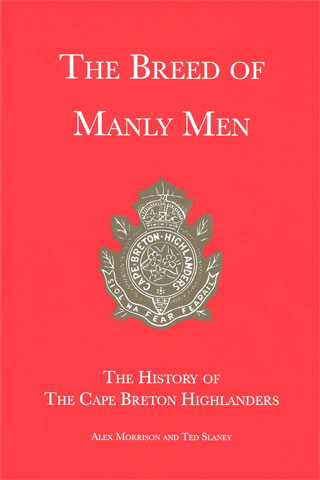
The Breed of Manly Men: The History of The
Cape Breton Highlanders.
This excellent, well written and interesting book is
still available ! Just click on the picture above to go to the
Editor's webpage.
Quotes shown on this webpage, which were taken from the above
Regimental History, will be indicated by the above picture.
Early Training

N.B.: the last mentioned
person in the back row, then still called "unknown", is actually
piper Gordie MacDonald, the first
C.B.H. battle fatality!
Excerpt from
Ch.2, Early Training p.29-37:
The CBH left Cape Breton
Island in five stages. On arrival in Saint John, the rail
parties were marched a mile and a half, "slipping and sliding on
the icy streets", each soldier with 60 pounds on his back, from
the station to the C.B.H. quarters at Barrack Green, accompanied
by the unit Pipe Band.
On 26 January, the C.B.H.
held its first Church Parade outside of Cape Breton. Another
Church Parade on 10 February marked the "unheralded public
debut" of the 25- member C.B.H. band. The Saint John Evening
Times-Globe reported that "the `skirl of the pipes' attracted
scores of spectators on their way to Church and comments of
praise were heard from many citizens who witnessed the Parade."
That same day, the C.B.H.
Pipes and Drums participated in a Canadian Broadcasting
Corporation national radio programme "On Parade".
They were introduced from the Montreal studios of the C.B.C.
where the program "On Parade" was being broadcast with the band
of His Majesty's Canadian Grenadier Guards. The pipers played
the regimental march pasts of the four highland units of the
Maritime Provinces: The Cape Breton Highlanders, The North Nova
Scotia Highlanders, The Prince Edward Island Highlanders, and
The Pictou Highlanders, and they also played the march "Colonel
Robinson"
After the broadcast the band made a recording of their tunes.
Some days later a prominent article on the first page of the
second section of the Evening Times-Globe featured the headline,
"No Scarcity of Pipes in Cape Breton Unit - Could Triple the
Band". The sub-heading informed readers that "Eight Highlander
Pipers Can Speak Gaelic as Well as English; Two Compose Marches,
Strathspeys and Reels." The writer outlined the history of the
C.B.H, its affiliation with The 22nd Cheshire Regiment and
mentioned that the Minister of National Defence was the Honorary
Colonel of the Regiment. As were others outside of Cape Breton,
he was fascinated that some band members "speak Gaelic just as
easily as English." The article also explained the difference
between a strathspey and a reel. Singled-out for particular
mention was Pipe-Major John A. (Black Jack) MacDonald, who, it
was noted, had written "Colonel Chisholm's March, Miss Elizabeth
MacKinnon's March, and Colonel Small's March". Also featured
were Private Gordon McQuarrie, who had also written for the
Pipes and a book on Scottish music, and Piper George Sutherland,
who "is said to be able to perform the difficult feat of playing
the practice chanter for a solid day without taking the
instrument from his lips."
Shortly after lunch hour, at 1315 hours on Tuesday, 25 February,
a fire broke out in the historic Exhibition Building. There were
strong winds that day and in ten minutes or so the main building
was entirely afire and sparks quickly ignited the drill hall, a
building used for offices, and a restaurant. The whole of the
Saint John Fire Department was called out and was aided by their
colleagues and equipment from West Saint John.
One soldier was killed, Regimental Sergeant-Major John Toms was
cut while escaping from a second storey window, and four
soldiers were badly burned. All of the C.B.H. records and
regimental property were destroyed.

P.M. "Black
Jack"MacDonald far left, 3 places behind him "Bull" Bill Gillis, pipe
major from 1942 and next to him on the right George Sutherland,
pipe major from september 1945

The C.B.H. Pipes and Drums
proved to be quite an attraction for the citizens of Saint John
and the local newspapers duly reported various events and
parades at which the band was hosted or featured. On 7 March,
Luxon Temple Patrol held a dinner for the C.B.H. officers and
the band. In honour of their guests, members of the Patrol
paraded and piped the haggis and the null. Toasts to King George
VI, the Armed Forces, and to the C.B.H. were proposed and
drunk. Captain AC Ross and Pipe-Major MacDonald spoke on behalf
of the unit. Privates J.J. MacMillan, Gordon MacQuarrie and
Palmer displayed their respective piano, fiddle and dancing
talents for their hosts.
The Barrack Green YMCA building was the scene for an amateur
show early in March. Although the C.B.H. participants did not
take top prize, "Private Joe McCormick ... played a pleasant
guitar accompaniment to his singing of old-time songs and won
third place ... Privates Timmins and Palmer brought the house
down with their clappers and drumsticks duel."
Although bad weather forced the Pipes and Drums to wear battle
dress instead of kilts, a parade scheduled for Tuesday, 25
March, took place as planned.
Again on 7 April, the unit band was the only one featured in a
large Church Parade.
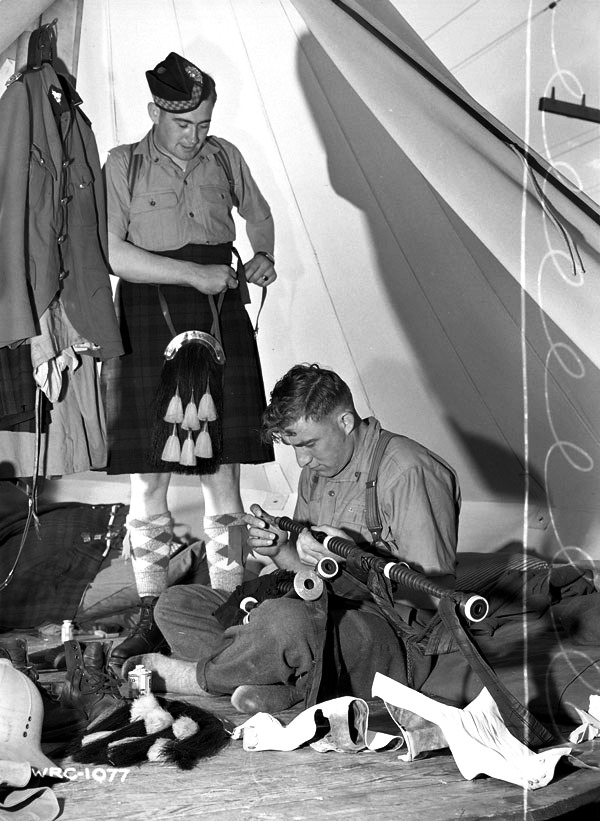
Infantrymen of The Cape Breton
Highlanders dressing for a parade during their stay at the
Connaught Ranges,
Ottawa, Ontario, Canada, 1941.
[1 may] The Pipe Band
turned out in full dress and played the regimental march past as
well as other pipe selections. All of the visitors were generous
in their praise of the "Boys from Cape Breton."
The C.B.H. mounted its first guard on Parliament Hill on Monday,
26 May in a drizzling rain, relieving a contingent from the
Royal Canadian Air Force (R.C.A.F.). It was the first Nova
Scotia unit to perform guard duties on the Hill. Marching from
Cartier Square Drill Hall and using the route along Elgin Street
still employed by the present-day Changing of the Guard units,
the C.B.H. contingent of 32 soldiers in summer dress commanded
by 2nd Lieutenant F.C.Small and accompanied by the Pipes and
Drums marched smartly to its duties.
On Friday the 13th of June, 127 new recruits from
Cape Breton joined the unit at Connaught. One of them was Ted
Slaney of Glace Bay:
Once we were able to
dress properly and looked presentable in uniform, we were
allowed to travel on the duty run to downtown Ottawa to see the
sights. On our first trip we were taken to see our unit perform
the Changing of the Guard on Parliament Hill. This impressed me
very much and made me proud to be a Cape Breton Highlander. Our
Regimental Pipes and Drums led by Pipe-Major Black Jack
MacDonald looked very sharp indeed, dressed as they were in
scarlet tunics, kilt, white hair sporran, and white spats. The
members of the Guard wore khaki drill uniforms consisting of
short-sleeved shirts and short pants. Completing the uniform
were long puttees, pith helmets, web gear including ammunition
pouches, small pack, and rifles with long bayonets and
scabbards. The rifles and bayonets glistened in the bright
Ottawa sun. All of this was in stark contrast to the RCAF Guard,
whose members wore their blue uniforms, soft hats, waist belt
and carried only rifle and bayonet.
The time spent in Camp
Borden had been short. After breakfast on 25 September, the
tents were taken down and the C.B.H. prepared to move to Camp
Debert, just outside Truro, NS. There they would make the final
preparations before leaving for overseas. While the troops were
waiting around to board the trains in the late afternoon and
early evening, a severe dust storm blew up; at times the winds
reached 50 miles per hour. Respirators provided some relief but
by the time the trains were loaded, "we were in some mess", and
it took hours to restore a semblance of personal cleanliness.
The 25 officers and 855 soldiers were all in their quarters in
Debert by 1940 hours on 28 September.

This tartan, the 42nd. or
Black Watch Tartan, was and still is worn by the Cape Breton
Highlanders.

Effective Saturday, 8 November, all personnel were confined to
Debert. The following day a Battalion muster parade was held and
the unit was informed that it would be proceeding overseas. Ted
Slaney recalls that "everyone was
happy to hear this news, and couldn't wait to get going."
THE MOVE TO GREAT
BRITAIN
Troop trains left for Halifax on 10 November.On arrival, the
Highlanders boarded H.M.T.S. ORCADES and settled in. All shore
passes were cancelled as of 0900 hours on Thursday 13 November
and at 1740 hours, almost 23 years to the day after the end of
the First World War, and almost 27 months after the beginning of
the Second World War, The Cape Breton Highlanders proceeded
overseas. Over four years would pass before the unit saw Halifax
again.
As the War Diary describes it:
The gangplank was raised and the ship pulled into the stream.
Darkness fell as we steamed slowly down the harbour, while
troops lined the decks for a last glimpse of Canada.
On 13
November 1941, the Cape Breton highlanders began their 11 day
voyage to England on the troopship S.S. Orcades.

Details
on
S.S.Orcades:
RMS
Orcades was a British built ocean liner that
served on the UK-Australia route as a Royal Mail
Shipfrom 1937-1939. Orcades was requistioned
by the British government as a troopship
in 1939.
Torpedoed and
sunk by German U-12 on 10 October 1942 with the loss
of 48 lives and 1,117 survivors. The survivors were
picked up by the SS Narvik a Polish steamship of
7,000 gross tons and owned by the Gdynia America
Line. RMS Orcades, commanded by a Captain Fox, left
Capetown on the 9th October 1942. On the 10th
October at about 11:30 in the morning she was hit by
2 torpedoes, but did not sink immediately. A third
torpedo missed but a fourth hit and she settled
beneath the waves at about 14:00.

Early in
the evening of 22 November, the ORCADES anchored in the River
Mersey, off Birkenhead. The CBH marched off the ship and onto
British soil at 1015 hours on Monday the 24th. They then boarded
trains (much smaller than the Canadian variety, and called "toy
trains" by the troops) for the ride to Maida Barracks at
Aldershot, England, just southwest of London.
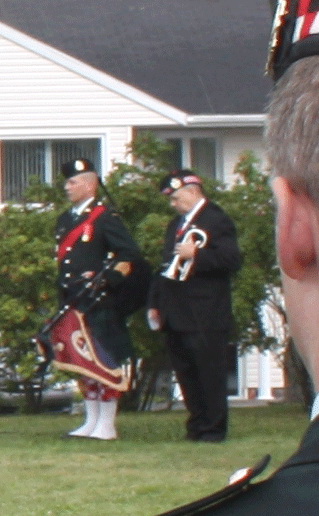
C.B.H.
Trumpeter Merle Stagg with present C.B.H. Pipe Major,
Mike Campbell -
still going strong at the Preunion before the recent 2011 C.B.H.
Rebadging.
Unit
Guards and Fire Picquets were mounted each evening in ceremonial
fashion by the R.S.M. Private Merv Stagg
had joined the C.B.H. in 1940 and became the primary unit
bugler. He has played at every C.B.H. Association reunion, every
Remembrance Day ceremony in North Sydney since 1946, and has
been a member of the Canadian Legion since the end of the war.
The Duty Bugler would play reveille, call to cookhouse for
meals, 30 minutes to parade, 15 minutes to parade, Orderly
Officer and Orderly Sergeant calls, call for training, call for
dinner, the 1600 hours retreat and lowering of the flag,
Mounting of the New Guard, First Post at 2200 hours, Last Post
at 2230 hours and Lights Out at 2245 hours. Truly, the daily
routine of the unit was conducted according to the sound of the
bugle. Soldiers were expected to know each of the calls and not
responding due to non-recognition was never a reason to escape
punishment. Indeed, they were obligated to know individual notes
also: three `G's was the blackout signal, ended by two `G's.
There was also a Duty Piper who played "Calls" as well. Many
soldiers remember the pipes at reveille playing "Johnny Cope"
and one particularly familiar tune, "A Man's A Man For All That"
which summoned to Defaulters Parade those who had misbehaved.
Piper Dan Gillis recalls some comical incidents
involving the band:
I recall that while we were staying in
tents in England, Willie Gillis was duty piper and had been out
late one night at a pub and slept in the next morning. Someone
rushed to his tent to awaken him and told him he was late in
playing for reveille. Willie grabbed his pipes and without
tuning them marched up and down the line of tents, bare naked.
It was a sight beyond description and so were the sounds.
Another time, Red Gordon MacQuarrie, who was an excellent
violinist as well as a piper, while we were billeted at
Sheffield Park, would take his fiddle to the Sheffield Arms to
play selections for the patrons and receive free drinks in
return.
One night after being well rewarded for his musical
contributions he strayed from the pathway through the woods on
his way back to camp. He walked onto a grassy glade which was
actually a swamp covered with algae under which was deep black
mire. He was completely covered with it when he arrived at camp,
after being rescued by some of the boys. He was no longer Red
Gordon but Black Gordon instead.

14 October, Colonel
Ralston inspecting the Cape Breton Highlanders
 Click on the above photograph to watch a clip of
the event; at the end you will see the 5th. Div. pipe Bands. Click on the above photograph to watch a clip of
the event; at the end you will see the 5th. Div. pipe Bands.

Colonel
Ralston arrived to visit his unit on 14 October. After
inspecting a Guard of Honour and the Battalion, he told the
Division Support Group that "The Cape Breton Highlanders will
never let you down." A picture was taken of the Honorary Colonel
with senior officers, the Guard of Honour and the Pipes and
Drums. One of the first persons Colonel Ralston met was
Pipe-Major Black Jack MacDonald with whom he had served in the
85th Battalion. On 22 March 1940, MacDonald left his job as
lighthouse keeper on St. Esprit Island and joined the C.B.H.
Having served with the 185th and then 85th, and married a girl
from Devonshire, the first thing he did on being granted landing
leave in England was to visit his father-in-law.
From 25 February until 14 April 1942, he was attached to the
Argyll and Sutherland Highlanders of the British Army for
further bagpipe instruction. In March of 1944, he was returned
to Canada due to age. Immediately becoming part of the C.B.H.
reserve battalion, he soldiered on for many years after the war
ended.
In 1942
William (Bull) Gillis takes over as Pipe Major, (read the newspaper text
further below)


(Left) This is the C.B.H. 5th.
Division battle patch with the Canada
title on top,
as you can see them worn on the photograph above (right).
The
helmet does also show a regimental decal on the left side.

Cape Breton Highlanders receive mail
in Britain before moving to Italy
N.B.: The soldier on
the left is wearing a brigade bar (denoting H.Q. of the Infantry
Brigade of 5th. Armoured Div.) between the Canada- and
Division- patch, the other one is wearing motorcyclist's gloves.
November
21, 1941 the regiment had arrived at Liverpool on the Orcades
and it would soon be boarding an American ship, The S.S.
Monterey, to leave England on the way to Italy, in "Operation
Timberwolf", which was the code name for the dispatch of
additional Canadian troops to the Italian theatre of
operations..
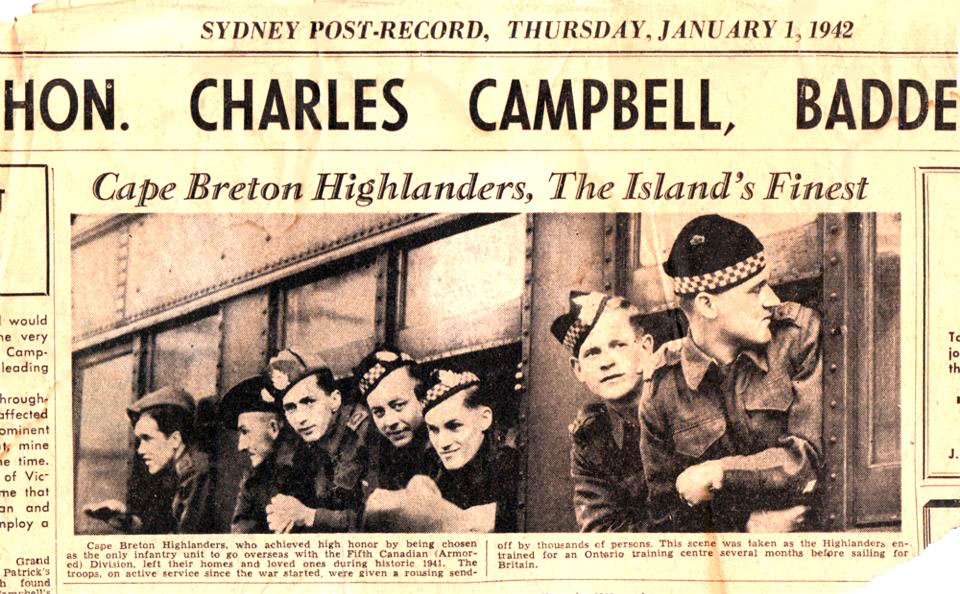
THE MOVE TO ITALY

Map of Operation
Timberwolf-locations, showing Sicily (left) and
Italy (right) with Naples and the name "5 Div"
On the 23 rd
of October the Regiment boarded the Grace Line
“Monterey” at Liverpool, all were aboard by 1730
hours all were aboard. Altogether, over 4,000
soldiers were on board: the C.B.H. (on B deck
promenade, both sides of the ship), The Irish
Regiment, and troops from HQ 11 C.I.B, Royal
Canadian Engineers, Royal Canadian Army Service
Corps, Royal Canadian Army Medical Corps, Royal
Canadian Corps of Signals and advance parties from
various armoured regiments. The Pipes and Drums
performed on deck to large crowds, often for two
hours at a time.
By the 4th of
November they were passing Gibraltar. The pleasant
passage which had until this time made life a round
of chicken was somewhat disturbed by an incident
which occurred on the evening of the 6th of
November. At about a quarter after six, just after
twilight, German aircraft attacked the convoy and
torpedoed both a Dutch ammunition ship and the
“Santa Elena”, another Grace Line ship, carrying
14th General Hospital, and a reinforcement
battalion. The Dutch ship was immediately destroyed
, but the “Elena” managed to stay barely afloat. The
“Monterey”, under Captain Johannsen, moved as close
as possible to the stricken ship, and lowered boats
to pick up survivors. Men of the Cape Breton
Highlanders of Canada and the Irish Regiment of
Canada, who had manned Bren Gun posts on the decks
during the battle with the aircraft were followed
now by other men who assisted in rowing the
lifeboats. All the troops of the Eleventh Bde., who
were on the ship, worked ceaselessly assisting the
survivors on board, lending them dry clothes, and
finding them something to drink and a place to
sleep. As present writer was one of the
unfortunates, he can well assert that the reception
accorded to the almost 1300 survivors was most
admirable.

The Troopship Monterey
From
http://en.wikipedia.org/wiki/SS_Monterey:
In World War II
Monterey served as a fast troop carrier, often
operating alone so she would not be slowed by
formation navigation in a convoy. The United States
Marine Corps chartered her in 1941 before the US
declaration of war to carry 150 Chinese, Korean and
Japanese missionaries and stranded US citizens back
to San Francisco. Once home, she was quickly
refitted to hold 3,500 soldiers. On 16 December 1941
she steamed to Hawaii with 3,349 fresh troops,
returning with 800 casualties of the attack on Pearl
Harbor.
On 22 August 1942, the ship was briefly
acquired by the United States Navy for use as a
troopship and assigned the name and designation USS
Alameda (AP-68), the second U.S. Navy ship to bear
that name. However, she was returned to the War
Shipping Administration on 25 September 1942 and
thus never served under that name.
War voyage:
8 October 1943 New York to Liverpool with
6,747 troops.
On to Gibraltar and Naples in convoy of 43 ships.
The voyage to Naples was her first taste of
combat.
On 6 November 1943 in an action off Cape Bougaroun,
Algeria, 25 aircraft attacked the convoy. Monterey
shot down an enemy bomber which passed over the ship
and tore away the radio mast before crashing into
the ocean. In convoy, the Grace Line troopship Santa
Elena was torpedoed and began to sink. Monterey
rescued 1,675 using her boats and nets, taking the
survivors to Naples.
On the 7th the ship anchored
for a day in Philippeville Harbour, but attempts to
transfer the survivors to another ship were
prevented by a heavy sea. That night the “Santa
Elena” was towed into the harbour, but sank a few
hundred yards from safety, almost exactly 24 hours
after having been torpedoed.
- It was at 0400
hours on the 10th of November 1943 that the ship
finally slipped into Naples harbour
and off-loading began shortly after 0800 hours,
exactly two years to the day after the CBH left
Halifax.

November 1943, Naples,
Italy: the Cape Breton Highlanders are piped ashore by their own
regimental Pipe Band
P.M. Gillis's hands are just
showing on the left edge here: proof of Cape Breton traditional style
left-handed piping!

The same event, but photograph
taken earlier and from a different angle.
Debarking from the Monterey - Claude Denny leads, followed by Sid
Tobin.

Excerpt
from
Ch.6, The Voyage to War, p.124-130:
After a march of some eight miles, the unit
reached its assigned staging area just outside the town
Afragola, about 35 miles from the Front Line. On 19 November
1943, the Battalion moved out and headed for Altamura with 108
vehicles.
On Christmas Eve night, members of all
denominations attended Midnight Mass in Altamura and were back
in the unit lines by 0130 hours. The
Battalion began the Christmas dinner at 1200 hours.
During the dinner, the Division Commander, Major-General Simonds
and the Brigade Commander, Brigadier Kitching came by to wish
the troops compliments of the season. The Pipes and Drums played
a few tunes and escorted the Officers to the Sergeants' Mess and
vice versa.
The Pipes and Drums of the C.B.H and the Irish
Regiment were selected to play for the daily changing of the
Brigade Guard in Altamura and thrilled thousands of Italians by
their musical talents and their highland dress. The soldiers
also appreciated the skirl of the pipes. It reminded them of
home and the Ceilidhs they had enjoyed in more peaceful times.
As only the pipers and drummers had
full-dress uniforms, the remainder having been destroyed in the
Saint John fire, the sight of them wearing the kilt and the
sporran was a highland heritage display greatly cherished.

Excerpt
from
Ch.7, The Valley of Death, p.138-139:
The first casualties occurred on 15 January at
about 1100 hours when the observation post occupied by
Lance-Corporal GH MacDonald and Private JA
MacKinnon
came under mortar fire. Private Steve Humeniuk watched from his
slit trench as the Germans ranged-in on the observation post,
one round landing in back then another in front and finally the
third very close to the two soldiers. Humeniuk and Private F
Thomas immediately went out and dragged the wounded Private
MacKinnon
back to A Company headquarters. Lance-Corporal MacDonald, from
New Waterford, a member of the Intelligence section and a
piper, had been killed. He was the first CBH fatal battle
casualty of the Second World War. As the word spread throughout
the unit, it hit each soldier with a shock. They were now really
and truly at war. He died within minutes of being hit but not
until he made an effort to pass information on the position of
the enemy. He is buried in the Moro River Canadian War Cemetery
near Ortona. It was an eerie coincidence as the first casualty
suffered by the 85th Battalion in the First World War was
another piper, Alex
Gillis
of Port Hood, who was wounded while on a work party at Vimy
Ridge on
23
February
1917.
Private
MacKinnon
was badly wounded and had one foot amputated.

+ L.Cpl. piper Gordie MacDonald
(in pre-war dress uniform)
the first
C.B.H. battle fatality
Piper Dan
Gillis
knew MacDonald well:
He was a very good friend of mine. We shared the
same slit trench and pup tent at Ortona. He often spoke of his
girlfriend in Scotland whom he planned to marry when the war was
over. I went to the cookhouse with him before he left for the
observation post on the morning he was killed. I was on kitchen
detail that day and I gave him some food rations. They were
still in his greatcoat pocket when the body was found. We had a
mutual agreement that should one of us not survive the war the
other would keep his practice chanter as a remembrance. I still
have Gordie's chanter.
Dan
Gillis
had joined the Army in June
1941
at St. George's Parish Hall in Sydney, and joined the C.B.H. in
Camp Borden after a short stay in Aldershot. Just before moving
overseas, he volunteered for the Signals Platoon and stayed
there until the summer of
1943.
At that time four of the pipers were being
retired to a holding unit because of their age so the band
needed some new recruits for their pipe section. I was asked to
join the band and Archie MacKay was assigned to teach me. I
loved Scottish music and was associated with it all my life. My
grandfather, my dad, his six brothers and one sister all played
the violin, so it was an enjoyable challenge for me. Learning to
play the pipes served me well in later years, for when I went to
live in Antigonish I was able to organize the Antigonish Legion
Pipe Band for which I was Pipe Sergeant for many years. I also
helped to organize the Legion Junior Pipe Band which won many
awards in Canada, USA and Europe. Two of my sons were pipers
with the band. Only three of the 14 pipers who served with the
C.B.H. overseas are still living; Archie MacKay and Willie
Gillis
are the other two.
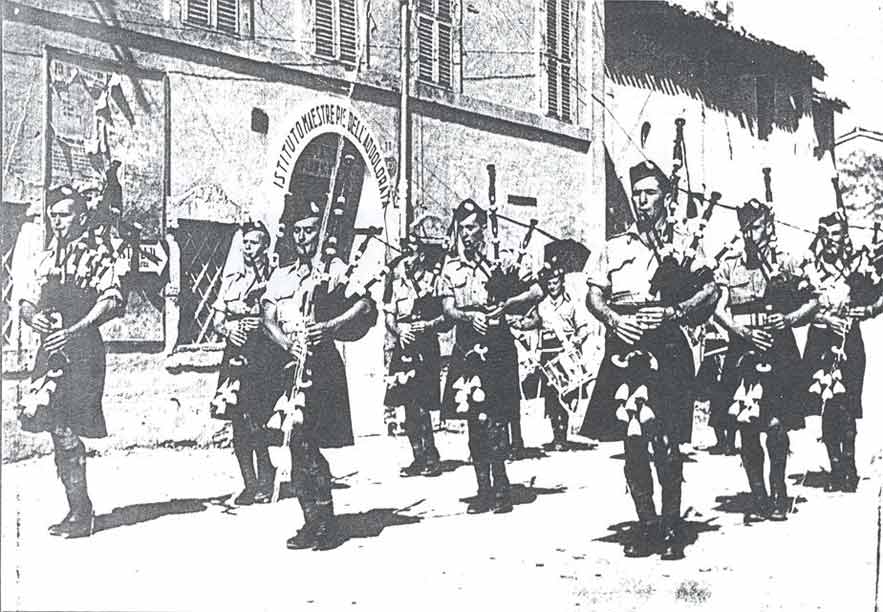
The C.B.H. Pipes and Drums
on the march
through an Italian town in 1944.
In the front rank, left to right Pipe Major Bill Gillis, John Archie
MacDonell, John MacMillan. In the second rank. the Cooper brothers
(Gordon and Malcolm) centred by Dan Gillis.
Archie MacKay and George Sutherland are in the third rank and Drummers
Judson and Clarence Hunt are visible at far right.
Do observe the "left handed"
reversed hand position of PipeMajor Gillis.
On 2
April, the Pipes and Drums honoured those who had fallen in
battle by the playing of "Lord Lovat's Lament." The band was
kept busy playing at other functions such as the closing
inspection of the N.C.O. School at GUGLIANESI.
General
Leese, the Army Commander, visited on 8 May, listened to the
combined Pipes and Drums of the CBH and The Irish Regiment,
watched each company conduct its training and then shook hands
with and spoke to each of the officers
On the 11th (of May), Douglas How, a war
correspondent who had been a C.B.H. officer in England, visited
his old platoon. That same day the Pipe Band were warned to be
ready to play retreat at 2000 hours. Normally all ranks wear
slacks in the evening as protection against malaria-carrying
mosquitoes. Pipe-Major Billy Gillis approached the Adjutant,
Captain R.T.Bonnell and asked for permission to dress the band
in kilts. Being very malaria conscious, he promised that the
band would take every precaution against mosquitoes, even if it
came to applying anti-mosquito ointment from the knees up.
Isn't it
terrible to be a Highlander?
Excerpt from
Ch.9, The Crossing of the Melfa, p.190:
The engineers were unable to put a bridge across
the LIRI and an attempt made to deliver rations by putting a
loaded jeep on the raft failed and all cargo went to the bottom
where it stayed until recovered the next day. CAMS George
MacAulay recalls:
I guess it would be about the last week in May
1944 that we crossed the LIRI River. My job was to help Captain
Frizzell lead a convoy
of
jeeps carrying meals to forward troops. We came
to the river just upstream from a Bailey bridge under
construction and under shell fire. I searched out the sergeant
and two men resting from their duties as crew of the craft which
would take us across. I asked for his help and he refused,
pleading exhaustion. I ordered him to help us and he still
refused. I then got him to explain what we had to do to operate
the craft.
The craft consisted of two planks lashed across
two canvas boats. The planks had sideboards to prevent
derailment
of the jeep.
Upstream from the craft a rope stretched between two banks. From
a wheel on this crossing rope two ropes led to the bows
of
the boats. When these ropes
were of
unequal length, so as to point the boats at an
angle to the current, the current carried the craft across the
river.
That was the theory. Before we got to mid-stream, we sank. There
were perhaps six or seven
of
us on board. Among the others were a cook named
Blackie,
C.Q.M.S.Dave Bellefontaine and Pipe-Major
Gillis,
acting as CQMS for Battalion Headquarters.
Blackie was washed downstream. Luckily, he did not pass into the
enemy lines. The Pipe-Major fell off on the upstream side and
would have been carried away under the Jeep had he not gotten a
death grip on it. It is correct to refer to it as a death grip,
for he kept shouting, "Get me out
of
here, I can't swim!"
Excerpt
from
Ch.10, A New Beginning, p.209:
The unit Padre, Father Alex D MacDonald, arranged
for some of the C.B.H. soldiers to take part in a general
audience with Pope Plus XII on 10 June. Sergeant Tom Kuchurean
was one of those who participated in the audience. He remembers
"the Pope greeting and addressing the
assemblage in various languages, and blessing us and any
religious articles we had as he was borne on his throne to and
from the room."
Another participant was Piper Dan
Gillis.
When the audience was over,
Gillis
decided to take a stroll through the streets of
Rome. At the end the first block, he met his brother Richard who
had been through the Sicilian and Italian campaigns with 2nd
Field Regiment RCA. "It was quite a reunion as it was only one
chance in a million that I would run into him."
The
Pipes and Drums continued to be active and spent one week at
AVELLINO entertaining patients at the 1st Canadian General
Hospital and also playing for those at the Reinforcement Unit.
In the middle of the week, the Band returned for a short time to
play at the Corps sports meet.

Excerpt from Ch.12, Coriano Ridge p.257
Two of those killed in action were Privates
William McLaren and James H
Marston,
both of B Company. They had been taken on strength on 11
September. Two days later they were dead. Another, Private
Joseph A
Rogers
of C Company had been with the C.B.H. for only a
week. One of the wounded officers was Lieutenant E Schrieber of
B Company, highly regarded by all the company NCOs and described
by them as "a good little officer"; one of the highest
compliments that could be paid to a platoon commander.
The unit Pipes and Drums were waiting for them
when they reached Battalion HQ and played them from the field to
the tune of "Highland Laddie". The War Diary records that
"everyone's spirits rose when the good old pipes were heard once
more."
One of the clearest memories of those who were
there that day is that of the pipes and the shivers of emotion
caused by hearing their distinctive sound. Piper Dan
Gillis'
brother was in A Company
and took part in the assaults on Hill 120 and
CORIANO Ridge:
At CORIANO Ridge we knew that there were many
casualties and the band was asked to play as the survivors were
coming back. It was a very difficult feeling to be piping and
watch as they came by to see
if
your brother would be with them. The tears ran
down my face as I saw him waving to us as he marched past. I
know that tears were in many eyes that day to see these battle
weary men show such a new sense of spirit and pride when they
heard the sound of the pipes.
Sergeant Karl MacKenzie, a staunch Scot who
supported the C.B.H. with his heavy machine-guns as a member of
the Princess
Louise
Fusiliers of Halifax, said he watched the C.B.H.
file down from the ridge, and when the pipes and drums struck
up, he was so overcome with emotion that he broke down and
cried.
Fifty years later, Bob
Kipping, who had been in the Mortar Platoon at CORIANO, was part
of the official Canadian delegation visiting the Italian
battlefields. While the landscape had changed much in the
intervening five decades, he found other memories. He notes:
I couldn't recognize any of the features on
the ground that we fought over, but on visiting CORIANO Ridge
Cemetery, I recognized the names of many friends and comrades on
the gravestones in the beautifully kept cemetery.
The memories of 50 years all flooded back and it was an
emotional occasion for us all, especially when the piper played
the Lament.
Shortly after the battle of CORIANO Ridge, a long
article extolling the C.B.H. performance appeared in
The Maple Leaf, called "Cape
Breton Lads Crack Ridge Line" and starts with:

"Highland Unit, Prominent in Coriano Fracas, Overcomes Rough
Opposition to Push Huns From Hills
South of
Rimini
By Sergeant Howard Rutsey Staff Writer, The Maple Leaf
With the Canadians on the Adriatic -They were
dog-tired, dirty, battle-worn but mighty proud.
No
guardsmen stepped with smarter tread than these Cape Breton
Highlanders as their kilted band piped them out of battle the
night of September
14."
Excerpt from Ch.13, Crossing The Lamone p.266:
Later that day, the CO told company
commanders that they really must work on improving the dress and
deportment of their soldiers.
Other administrative activities which took place during this
quiet period included a C.B.H. and 6 Battalion Argyle and
Sutherland Highlanders massed Pipes and Drums concert in the SAN
GIOVANNI
town square.

The New Embroidered
C.B.H.Title - an economy version, printed on canvas, was also
made.
On the 21st, all ranks were issued "the new
battalion flash which has gold lettering on a crimson background
and reads 'The Cape Breton Highlanders Canada'. These patches,
along with the silver and red service chevrons brings the C.B.H.
to the fore among conspicuous units in this town." The previous
flash was a rather simple rectangular one with "C.B.H." on it.
There had also been a flash with "Cape Breton Highlanders" on it
which was "slipped-on" the shirt, tunic, etc. shoulder strap.
(The canvas printed titles
were authorized in November of 1942, came into widespread use in
1943, and were to be phased out in the spring of 1945. It
appears that printed titles were often issued during the
repatriation process in the summer of 1945.)
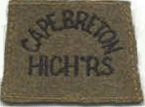
The Pre-war C.B.H. shoulder
strap slip-on
Excerpt from Ch.13, Crossing The Lamone p.268:
Even though B Company and
the Pipes and Drums were in RIMINI attending a briefing on the
progress of the war, the unit was ordered to move back into the
Line and relieve 4PLDG the night of the 4th.
Excerpt from Ch.13, Crossing The Lamone p.270:
[19 October] The normal rest area program of
training and recreation was put into effect and included 48
hours leave in RICCIONE, concerts given by the Pipes and Drums,
range work and a communications Exercise SUDS.
November 1,
1943 Article from The Halifax Herald

The description of this newspaper clipping is below here.
Excerpt from Ch.13, Crossing The Lamone p.275:
One of Doug How's regular dispatches from Italy,
dated 1 November, commented on the tradition of the CBH Pipes
and Drums under Pipe-Major Bill
Gillis
of piping the troops out of the Line.
Three extracts from that article are of
particular interest as they recount anecdotes not normally found
in the unit War Diary or other official reports:
It can be reported to Pipe-Major J.A.(Blackjack)
MacDonald back in Sydney, NS, that The Cape Breton Highlanders'
pipe band he commanded for so long is playing with a pride and
ability that has given it a definite place within the division
of which the battalion is a part.
Pipe-Major William Gillis of Inverness, N.S., and
his kilted band of nine pipers and seven drummers recently
played along an Italian road while two Canadian battalions moved
up into the Line and three, including their own and a New
Zealand unit, moved out. Soldiers who came out tired, dirty,
slouching, marched with a new and sudden smartness as the pipes
swung into the regimental march past "Highland Laddie" and
others of the Scottish tunes.
This practice has become standard with the
regiment but nowhere did it have more effect and more feeling
than when the men came out of the Line after the tough, costly
attack on CORIANO Ridge.
Excerpt from Ch.13, Crossing The Lamone p.276-277:
HQ 11
C.I.B.
issued an instruction on 5 November which
directed each unit to supply one N.C.O. and 14 soldiers as a
Ceremonial Guard in the town square. The C.B.H. Pipes and Drums
would play the unit Guard on and off parade and would also play
for the Guards of units without a band. The unit Duty Officer
was responsible for inspecting the Guard to ensure a proper
turn out.
The C.B.H. provided the Guard on seven occasions
in November and the band played an additional six times. Roving
patrols and Picquets were also to be supplied by each unit.
Remembrance Day was marked by a ceremony in each company area. A
piper played the lament before and after the two-minutes'
silence.
Excerpt from Ch.13, Crossing The Lamone p.289:
The first C.B.H. Christmas spent in the Front
Line was relatively uneventful for the Canadians but not for
some Germans who were spotted on the dyke in front of the C.B.H.
position. Artillery fire quickly disposed of them. Again, from
Private MacNeil: "during Christmas the enemy seldom fired at us.
We could hear them sing Christmas carols and the occasional 'Canadesi
Swine' mixed in with their songs. Our 3-inch mortars hammered
them almost continuously." On Christmas Night:
The CO decided to visit some
of
the companies, so at 2230, he, the IO, and RSM
and the Provost Sergeant,
with the two pipers,
set out in two jeeps for D Company. It was on this trip, after
they had debussed and were nearing one
of
D Company's positions that a sentry challenged
them. Either the party were making too much noise or the sentry
didn't holler loud enough. At any rate, he wasn't heard, and the
second time he challenged with a burst from his Tommy-gun, and
from all reports, the scrambling for cover was the fastest ever
took place. The situation was well in hand in a very short time,
however, and the CO and his party proceeded on their patrol.

Excerpt from Ch.13, Crossing The Lamone p.290-291:
Lieutenant Roy
remembers Christmas Eve as follows:
All in all it was a very nice dinner with the bagpipes playing
and everyone quite cheery and happy toasting a merrier Christmas
back home next year.
On Boxing Day, the Pipes and Drums played
Reveille in the Front Line for the first time.
Major M.F. MacLachlan received word that his two wounds and
three years of overseas service meant that he could return to
Canada for a six-month tour of duty. He immediately left the
battalion area.
On the 27th, the unit was relieved by The Lanark and Renfrew
Scottish.
When the forward companies had moved back to the rear of
battalion headquarters, they found the Pipe Band there to
entertain them.
By 2100 hours, all ranks were in RAVENNA some ten miles to the
rear.
Excerpt from Ch.14, Bonifica And North-West Europe p.303:
Near the end of the month,
C.S.M.
D.D. Bellefontaine, M.M., and Private J.J.
MacMillan of the Pipe Band attended a dinner at Corps
Headquarters held in honour of Lieutenant-General McCreery, the
Army Commander.
Major-General Hoffmeister visited the battalion
on January the 26th and stayed for three hours.
Some of the events set-out in the War Diary for this visit were:
0915 to 0930 hours.......... Visit Pipe Band
Practising.
1145 to 1200 hours.......... Officers Mess (Pipe
Band).
"He left well pleased. Everything he inspected
was in perfect shape, so there was little cause for complaint."

In Italy: (back) (?) Currie, Neil Gillis, Bob Kipping, Sgt.
Keeping, (front) Frank Musgrave, Roscoe Nicholson, Tom Kucherean.
Excerpt from Ch.14, Bonifica And North-West Europe p.304:
"The Cape Breton Highlanders FROLICS OF 1945"
stage show was conducted on 1 February in the MORCIANO town
theatre, and was attended by the Brigade commander and a large
audience. Part of the program, published by Lance-Corporal FE
Musgrave, was as follows:
1. Regimental March Past by Pipe Band
4. Piping by Archie Allan MacKay
10. Eightsome Reel - Pipe Band
Excerpt from Ch.14, Bonifica And North-West Europe p.305
The battalion area was cleaned up on the 14th.
Reveille the next morning was at 0500 hours, and the battalion
moved off three hours later. At that time, the soldiers were
told that they were participating in Exercise GOLDFLAKE.
The C.B.H.
movement order of 12 February was a short one, but was heavy on
security.
One of the security requirements for instance was:
All mail will be strictly censored and
no reference to move will be made. No Maple Leafs or cigarette
boxes will be thrown from vehicles, but will be collected at all
staging areas and burned under coy arrangements. Hat badges,
flashes, patches, Canada’s, Canadian Volunteer Service Medal
ribbons, service chevrons, and vehicle markings exclusive of
62's will be removed.
Excerpt from Ch.14, Bonifica And North-West Europe p.307:
By the 17th, the Highlanders were in "a small
wood between PISA and
LEGHORN,
called Harrod's No.2
Camp" with the rest of the division. Word was passed that "we
were definitely leaving the country and everyone seemed happy
about it." At 1430 hours on the 19th, A Company plus some others
left the unit area to the skirl of the pipes.
Three pipers were included with A
Company so that the soldiers would have familiar music on
disembarkation.
THE MOVE
TO FRANCE and HOLLAND
Click on the
arrow picture below here to continue:


|
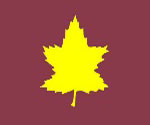
 THE CAPE BRETON HIGHLANDERS
THE CAPE BRETON HIGHLANDERS 































